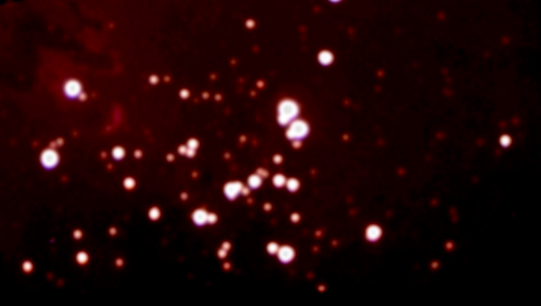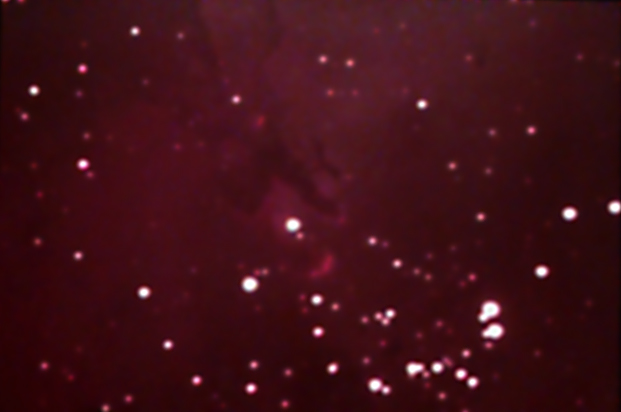
M16: Eagle Nebula

RA: 18hrs 18min 48sec Dec: -13º 47' 00" Mag: 8.0 Distance: 8000 light years Constellation: Serpens Cauda
What is pictured here is a segment of the Eagle nebula (in the top left hand corner) including the so-called 'pillars of creation' but the picture was centred on the open cluster of stars which is M16. The dramatic mixture of fluorescing hydrogen gas and cold dust constitutes a stellar nursery where stars are formed. The nebulosity was invisible to the eye through the eyepiece at f6.3 so the star cluster was used to centre the image. This was a nightmare of midtone enhancement in order to demonstrate the nebulosity, but being a first attempt, I was prepared to accept whatever came of it. This photo was taken on the 8th of August 2005 - very late in the season to be taking photos of objects below the celestial equator for this location - it was low on the horizon and poised to set even before midnight. I took exposures for as long as I could but now that I know where the interesting nebulosity occurs in the cluster, I shall take a better picture next year.
This picture is the combination of 11 raw images, each derived from numerous 15 second exposures (16x15, 7x15, 7x15, 14x15, 14x15, 14x15, 14x15, 14x15, 10x15, 14x15, 6x15) for a total exposure time of 32 minutes, 30 seconds. With that many stacks and the problem of vertical drift of the image with time, the borders of each different stacked frame were highly visible and they prevented me from using the full size of the image as they needed to be cropped out. Histogram stretching was carried out in the Luminosity (RGB) Levels command since there was no colour adjustments that I wanted to make. Subsequent midtone enhancement was extreme and carried out to the limit allowed by the resolution of the picture. As it was - there was some slight 'overdigitisation' which had to be smoothed out with Gaussian blur (radius 1.4) to provide the final image.
Problems - the picture needed better framing - if only the object had been moved more to the lower right, I would have caught the eagle shape of dark dust and bright nebulosity around the pillars of creation. Even longer exposure might have reduced the amount of midtone enhancement and consequently, the stellar blooms that you see in this photograph. Finally - I'm sure the picture would be better with a nebula filter - perhaps a broadband LPF such as the Meade 908B or Lumicon Deep Sky.
M16 - 2nd Attempt

This second attempt at the Eagle nebula with the M16 open cluster was taken on the night of the 20th September between 9pm and 11pm. The white floodlights of an outdoor sports club filled the horizon in the direction of Serpens Cauda and there was very little spread between air temperature and dew point. For this picture, I had been lent an Antares broadband LPF 1.25" filter by an astronomer-neighbour ("Thank you very much, Dick! I must get one of those for myself!"). Certainly, when viewed through a 26mm eyepiece and f6.3 focal reducer, the filter increased the contrast between sky and nebulosity which glowed a grey-silver hue once my eyes had accomodated sufficiently.
This photo is the composite of 3 raw images, (40x21 seconds, 6x21 seconds and 80x21 seconds) with a total exposure time of 44 minutes, 31 seconds. Histogram stretching was carried out in each of the R, G and B channels retaining the ratio of Red to both Green and Blue. I found however, that with the excessive midtone enhancement as in the previous attempt - there was digitisation of the nebulosity and severe blooming of the stars, with the result that the two double binaries in the cluster have fused to form keyhole shapes! In order to rid myself of the digitisation, Gaussian blur was applied up to a radius of about 2 to 2.5 pixels. This made the stars extremely fuzzy so an Unsharp mask was applied at 400%, radius = 1.2, threshold=3. The end result is as you see - fuzzy stars, but much less so than they would have been otherwise. I have lost resolution in the heart of the nebulosity around the cold dust areas because of the blurring.
Problems: next time - will go for several hours of exposure so that less midtone enhancement will be required.
HOME PICTURES: Deep Sky PICTURES: Solar system PICTURES: Wide field